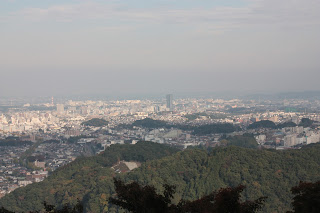Aquest és el meu últim missatge de l'any ja que d'aquí ben poquet estaré volant cap Europa per passar el Nadal! I per acabar, una sobre el "nadal japonès", com us deia aquí se celebra ben poc ara si hi ha alguna cosa que potser ha esdevingut en certa forma una tradició (almenys a Tokyo) és anar en un Kentucky fried chicken (KFC) el dia de Nadal...sí sí us asseguro que és veritat de fet com podeu veure a sota ja fa dies que els d KFC estan fent campanya amb menús especials i fins i tot reserves anticipades. I quina és la raó? Doncs bé de moment ja m'han arribat tres teories totes tres associades amb l'arribada dels americans després de la II guerra mundial:
1-KFC va ser una de primeres empreses americanes d serveis d'entrar al Japó i els japonesos que van conèixer aquesta festivitat a gravera dels americans van associar-ho amb KFC
2-aquesta diu simplement que algú de KFC (a qui s'hauria de fer un monoment) va veure la oportunitat de màrqueting que representava el creixent interès japones per tot el que era occidental i va posicionar KFC com el lloc on anar a celebrar el Nadal
3-finalment es diu també q com que EEUU hi ha tradició de menjar pollastre rostit doncs els japonesos van creure que KFC era el que més s'hi acostava...fregit, rostit...al final tot és pollastre :-)
Bé doncs una petita anècdota per acabar l'any! Bones festes a tothom i millor 2011!!
This is my last post of the year since in few hours I'll flying back to Europe for Xmas! And so, it is about the "Japanese Xmas ". As I said before this is not a festivity that is part of their culture but if there is something that became somehow traditional (at least in Tokyo), is not other but going to a Kentucky fried chicken (KFC) on the Xmas day...yes indeed this is true and as a matter of fact since some weeks ago KFC is advertising special menus and having even advanced reservations for that day! So now the question is, where does it come this tradition? Well, so far I've heard about three different stories but all related to the Americans entrance after the IIWW:
1- KFC was one of the first American service companies settled in Japan and as the Japanese knew about Xmas through them somehow they associate this festivity with KFC
2-this one says that there was someone at KFC that realized about the growing interest of the Japanese towards the western societies and so a great marketing opportunity positioning KFC as the place where to celebrate Xmas
3-and finally it is also said that as the Americans used to have roasted chicken on Xmas, the Japanese found that KFC was the closest thing to that...fried, roasted...and the end is all chicken :-)
A funny story to close this year. Merry Xmas and wonderful 2011!!
1-KFC va ser una de primeres empreses americanes d serveis d'entrar al Japó i els japonesos que van conèixer aquesta festivitat a gravera dels americans van associar-ho amb KFC
2-aquesta diu simplement que algú de KFC (a qui s'hauria de fer un monoment) va veure la oportunitat de màrqueting que representava el creixent interès japones per tot el que era occidental i va posicionar KFC com el lloc on anar a celebrar el Nadal
3-finalment es diu també q com que EEUU hi ha tradició de menjar pollastre rostit doncs els japonesos van creure que KFC era el que més s'hi acostava...fregit, rostit...al final tot és pollastre :-)
Bé doncs una petita anècdota per acabar l'any! Bones festes a tothom i millor 2011!!
This is my last post of the year since in few hours I'll flying back to Europe for Xmas! And so, it is about the "Japanese Xmas ". As I said before this is not a festivity that is part of their culture but if there is something that became somehow traditional (at least in Tokyo), is not other but going to a Kentucky fried chicken (KFC) on the Xmas day...yes indeed this is true and as a matter of fact since some weeks ago KFC is advertising special menus and having even advanced reservations for that day! So now the question is, where does it come this tradition? Well, so far I've heard about three different stories but all related to the Americans entrance after the IIWW:
1- KFC was one of the first American service companies settled in Japan and as the Japanese knew about Xmas through them somehow they associate this festivity with KFC
2-this one says that there was someone at KFC that realized about the growing interest of the Japanese towards the western societies and so a great marketing opportunity positioning KFC as the place where to celebrate Xmas
3-and finally it is also said that as the Americans used to have roasted chicken on Xmas, the Japanese found that KFC was the closest thing to that...fried, roasted...and the end is all chicken :-)
A funny story to close this year. Merry Xmas and wonderful 2011!!


















































